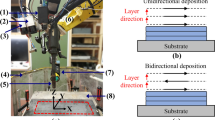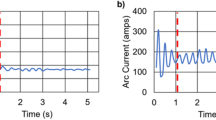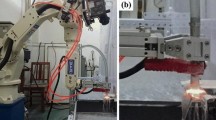Abstract
The dimensional consistency of multi-track multi-layer parts fabricated by gas metal arc-directed energy deposition is by far the most critical challenge. A systematic investigation is presented here to examine the influence of the important process variables such as wire feed rate, printing travel speed and resulting energy input per unit length on the dimensional consistency and surface waviness of multi-track and multi-layer parts made by gas metal arc directed energy deposition using an aluminium alloy filler wire. The current and voltage transients are monitored in real-time to realize a quantitative measure of the arc power and energy input per unit length of deposition on the build profile and its dimensional consistency. The dimensional consistency and the surface waviness of the build profile are measured by optical microscopy. The microhardness distribution of the sample builds along the tracks and layers is also examined for different process conditions and the effect of energy input per unit length on microhardness distribution has been examined. The evaluation of the experimentally measured results shows that the dimensional inconsistency and surface unevenness of the deposited profiles can be reduced significantly by increasing the energy input per unit length for gas metal arc-directed energy deposition.










Similar content being viewed by others
Abbreviations
- GMAW:
-
Gas metal arc welding
- GMA-DED:
-
Gas metal arc directed energy deposition
- GTA-DED:
-
Gas tungsten arc directed energy deposition
- PTS:
-
Printing travel speed/mm/s
- WFR:
-
Wire feed rate/m/min
- E :
-
Energy input per unit length/J/mm
- h :
-
Track height/mm
- h e :
-
Effective height/mm
- h t :
-
Measured height/mm
- I a :
-
Arc current/A
- I i :
-
Instantaneous arc current/A
- p :
-
Penetration/mm
- P :
-
Arc power/W
- t :
-
Total cycle time/ms
- t B :
-
Pulse-off time/ms
- t P :
-
Pulse-on time/ms
- t i :
-
Instantaneous time/ms
- V a :
-
Arc voltage/V
- V i :
-
Instantaneous arc voltage/V
- w :
-
Track width/mm
- w e :
-
Effective width/mm
- w m :
-
Measured width/mm
- δ :
-
Hatch spacing/mm
References
Lockett H, Ding J, Williams S, Martina F (2017) Design for wire + arc additive manufacture: design rules and build orientation selection. J Eng Des 28:568–598. https://doi.org/10.1080/09544828.2017.1365826
DebRoy T, Wei HL, Zuback JS, Mukherjee T, Elmer JW, Milewski JO et al (2018) Additive manufacturing of metallic components – process, structure and properties. Prog Mater Sci 92:112–224. https://doi.org/10.1016/j.pmatsci.2017.10.001
Wu B, Pan Z, Ding D, Cuiuri D, Li H, Xu J et al (2018) A review of the wire arc additive manufacturing of metals: properties, defects and quality improvement. J Manuf Processes 35:127–139. https://doi.org/10.1016/j.jmapro.2018.08.001
Chaurasia PK, Goecke SF, De A (2022) Real-time monitoring of temperature field, metal transfer and cooling rate during gas metal arc-directed energy deposition. Sci Technol Weld Join 27:512–521. https://doi.org/10.1080/13621718.2022.2080447
Williams SW, Martina F, Addison AC, Ding J, Pardal G, Colegrove P (2016) wire + arc additive manufacturing. Mater Sci Technol 32:641–647. https://doi.org/10.1179/1743284715Y.0000000073
Wang Y, Zhang C, Lu J, Bai L, Zhao Z, Han J (2020) Weld reinforcement analysis based on long-term prediction of molten pool image in additive manufacturing. IEEE Access 8:69908–69918. https://doi.org/10.1109/access.2020.2986130
Li Y, Polden J, Pan Z, Cui J, Xia C, He F et al (2022) A defect detection system for wire arc additive manufacturing using incremental learning. J Ind Inf Integr 27:100291. https://doi.org/10.1016/j.jii.2021.100291
Hauser T, Reisch RT, Seebauer S, Parasar A, Kamps T, Casati R et al (2021) Multi-material wire arc additive manufacturing of low and high alloyed aluminium alloys with in-situ material analysis. J Manuf Processes 69:378–390. https://doi.org/10.1016/j.jmapro.2021.08.005
Li Y, Han Q, Zhang G, Horváth I (2018) A layers-overlapping strategy for robotic wire and arc additive manufacturing of multi-layer multi-bead components with homogeneous layers. J Adv Manuf Technol 96:3331–3344. https://doi.org/10.1007/s00170-018-1786-3
Chaurasia PK, Goecke S-F, De A (2023) Monitoring melt pool asymmetry in gas metal arc-directed energy deposition. Sci Technol Weld Join 1-9. https://doi.org/10.1080/13621718.2023.2168933
Ali Y, Henckell P, Hildebrand J, Reimann J, Bergmann JP, Barnikol-Oettler S (2019) Wire arc additive manufacturing of hot work tool steel with CMT process. J Mater Process Technol 269:109–116. https://doi.org/10.1016/j.jmatprotec.2019.01.034
Rodrigues TA, Duarte V, Avila JA, Santos TG, Miranda RM, Oliveira JP (2019) Wire and arc additive manufacturing of HSLA steel: effect of thermal cycles on microstructure and mechanical properties. Addit Manuf 27:440–450. https://doi.org/10.1016/j.addma.2019.03.029
Ogino Y, Asai S, Hirata Y (2018) Numerical simulation of WAAM process by a GMAW weld pool model. Weld World 62:393–401. https://doi.org/10.1007/s40194-018-0556-z
Le VT, Mai DS, Hoang QH (2020) A study on wire and arc additive manufacturing of low-carbon steel components: process stability, microstructural and mechanical properties. J Braz Soc Mech Sci Eng 42:480. https://doi.org/10.1007/s40430-020-02567-0
Xia C, Pan Z, Polden J, Li H, Xu Y, Chen S et al (2020) A review on wire arc additive manufacturing: monitoring, control and a framework of automated system. J Manuf Syst 57:31–45. https://doi.org/10.1016/j.jmsy.2020.08.008
Wu B, Pan Z, Chen G, Ding D, Yuan L, Cuiuri D et al (2019) Mitigation of thermal distortion in wire arc additively manufactured Ti6Al4V part using active interpass cooling. Sci Technol Weld Join 24:484–494. https://doi.org/10.1080/13621718.2019.1580439
Zhai W, Wu N, Zhou W (2022) Effect of interpass temperature on wire arc additive manufacturing using high-strength metal-cored wire. Met 12:212. https://doi.org/10.3390/met12020212
Le VT, Mai DS, Bui MC, Wasmer K, Nguyen VA, Dinh DM et al (2022) Influences of the process parameter and thermal cycles on the quality of 308L stainless steel walls produced by additive manufacturing utilizing an arc welding source. Weld World 66:1565–1580. https://doi.org/10.1007/s40194-022-01330-4
Novelino ALB, Carvalho GC, Ziberov M (2022) Influence of WAAM-CMT deposition parameters on wall geometry. Adv Ind Manuf Eng 5:100105. https://doi.org/10.1016/j.aime.2022.100105
Chaurasia PK, Goecke SF, De A (2023) Towards real-time monitoring of metal transfer and melt pool temperature field in gas metal arc directed energy deposition. Weld World 1-11. https://doi.org/10.1007/s40194-023-01534-2
Geng H, Li J, Xiong J, Lin X, Huang D, Zhang F (2018) Formation and improvement of surface waviness for additive manufacturing 5A06 aluminium alloy component with GTAW system. Rapid Prototyp J 24:342–350. https://doi.org/10.1108/rpj-04-2016-0064
Zhou X, Zhang H, Wang G, Bai X (2016) Three-dimensional numerical simulation of arc and metal transport in arc welding based additive manufacturing. Int J Heat Mass Transfer 103:521–537. https://doi.org/10.1016/j.ijheatmasstransfer.2016.06.084
Ou W, Knapp GL, Mukherjee T, Wei Y, DebRoy T (2021) An improved heat transfer and fluid flow model of wire-arc additive manufacturing. Int J Heat Mass Transfer 167:120835–120835. https://doi.org/10.1016/j.ijheatmasstransfer.2020.120835
Cao H, Huang R, Yi H, Liu M, Jia L (2022) Asymmetric molten pool morphology in wire-arc directed energy deposition: evolution mechanism and suppression strategy. Addit Manuf 59A:103113. https://doi.org/10.1016/j.addma.2022.103113
Ge J, Ma T, Chen Y, Jin T, Fu H, Xiao R et al (2019) Wire-arc additive manufacturing H13 part: 3D pore distribution, microstructural evolution, and mechanical performances. J Alloys Compd 783:145–155. https://doi.org/10.1016/j.jallcom.2018.12.274
Zhou X, Tian Q, Du Y, Zhang Y, Bai X, Zhang Y et al (2021) Investigation of the effect of torch tilt and external magnetic field on arc during overlapping deposition of wire arc additive manufacturing. Rapid Prototyp J 27:24–36. https://doi.org/10.1108/RPJ-03-2020-0047
Xiong J, Zhang G, Gao H, Wu L (2013) Modeling of bead section profile and overlapping beads with experimental validation for robotic GMAW-based rapid manufacturing. Rob Comput Integr Manuf 29:417–423. https://doi.org/10.1016/j.rcim.2012.09.011
Plangger J, Schabhüttl P, Vuherer T, Enzinger N (2019) CMT additive manufacturing of a high strength steel alloy for application in crane construction. Met 9:650. https://doi.org/10.3390/met9060650
Ding D, Pan Z, Cuiuri D, Li H (2015) A multi-bead overlapping model for robotic wire and arc additive manufacturing (WAAM). Rob Comput Integr Manuf 31:101–110. https://doi.org/10.1016/j.rcim.2014.08.008
Suryakumar S, Karunakaran KP, Bernard A, Chandrasekhar U, Raghavender N, Sharma D (2011) Weld bead modeling and process optimization in hybrid layered manufacturing. Comput-Aided Des 43:331–344. https://doi.org/10.1016/j.cad.2011.01.006
Pattanayak S, Sahoo SK (2023) Effect of travel speed and number of layers on surface waviness of ER70S6 deposits fabricated through non-transferred wire arc additive manufacturing. J Adhes Sci Technol. https://doi.org/10.1080/01694243.2023.2217541
Pramod M, Kumar SM, Girinath B, Kannan AR, Kumar NP, Shanmugam NS (2020) Fabrication, characterisation, and finite element analysis of cold metal transfer-based wire and arc additive–manufactured aluminium alloy 4043 cylinder. Weld World 64:1905–1919. https://doi.org/10.1007/s40194-020-00970-8
Scotti FM, Teixeira FR, Silva LJ, de Araújo DB, Reis RP, Scotti A (2020) Thermal management in WAAM through the CMT Advanced process and an active cooling technique. J Manuf Processes 57:23–35. https://doi.org/10.1016/j.jmapro.2020.06.007
Acknowledgements
We gratefully acknowledge the support from the Indo-German Science and Technology Centre (IGSTC) grant IGSTC/Call 2020/RAMFLICS/52/2021-22/253 for carrying out this work at the Indian Institute of Technology Bombay.
Author information
Authors and Affiliations
Contributions
PKC: experimentation, analysis, measurements, writing—original draft. BKB: experimentation, analysis, measurements, writing—review and editing, AD: analysis, measurements, writing—review and editing, SFG: conceptualization, writing—review and editing. AD: conceptualization, writing—review and editing.
Corresponding author
Ethics declarations
Competing interests
The authors declare no competing interests.
Additional information
Publisher’s note
Springer Nature remains neutral with regard to jurisdictional claims in published maps and institutional affiliations.
Recommended for publication by Commission XII - Arc Welding Processes and Production Systems
Appendices
Appendix 1 Single-track multi-layer wall deposits
Figure 11a–c and d–f show the transverse cross-section profiles of the single-track five- and nine-layer aluminium wall deposits at three different process conditions; S1–S3 (Table 2). As the energy input increases, the average width of the wall is found to increase for five- and nine-layer wall deposits. This is attributed to the increase in the rate of depositing material with an increase in the WFR at constant PTS or a decrease in the PTS at constant WFR. The measured width (wm) and surface waviness along the wall height are presented in Fig. 5a, b for the single-track five- and nine-layer wall deposits shown in Figs 11a–f, followed by a detailed discussion in Section 3.2.
Appendix 2 Multi-track multi-layer build deposits
Figure 12a, b shows the transverse cross-section profiles of the five-track nine-layer aluminium builds at two different process conditions; S1 and S3 (Table 2). As observed in Fig. 11a–c and d–f, the overall build width is found to increase with an increase in the energy input for the five-track nine-layer build deposits shown in Fig. 12a, b. The measured build width (wm) and surface waviness along the build height are presented in Fig. 8a–d for the five-track nine-layer wall deposits at all three process conditions (Table 2), followed by a detailed discussion in Section 3.2. Further, the surface waviness along the top surface across the effective build width is also presented in Fig. 9d for all three process conditions (Table 2) and discussed subsequently.
Transverse cross-sectional views of the five-track nine-layer build deposits at two different conditions; a S1 (WFR: 5 m/min, PTS: 5 mm/s, E: 163 J/mm) and b S3 (WFR: 6 m/min, PTS: 7.5 mm/s, E: 173 J/mm). The transverse cross-sectional profile at S2 condition is already shown in Fig. 4
Rights and permissions
Springer Nature or its licensor (e.g. a society or other partner) holds exclusive rights to this article under a publishing agreement with the author(s) or other rightsholder(s); author self-archiving of the accepted manuscript version of this article is solely governed by the terms of such publishing agreement and applicable law.
About this article
Cite this article
Chaurasia, P.K., Barik, B.K., Das, A. et al. Probing dimensional consistency during multi-track multi-layer gas metal arc directed energy deposition of aluminium alloys. Weld World 68, 925–938 (2024). https://doi.org/10.1007/s40194-024-01685-w
Received:
Accepted:
Published:
Issue Date:
DOI: https://doi.org/10.1007/s40194-024-01685-w






